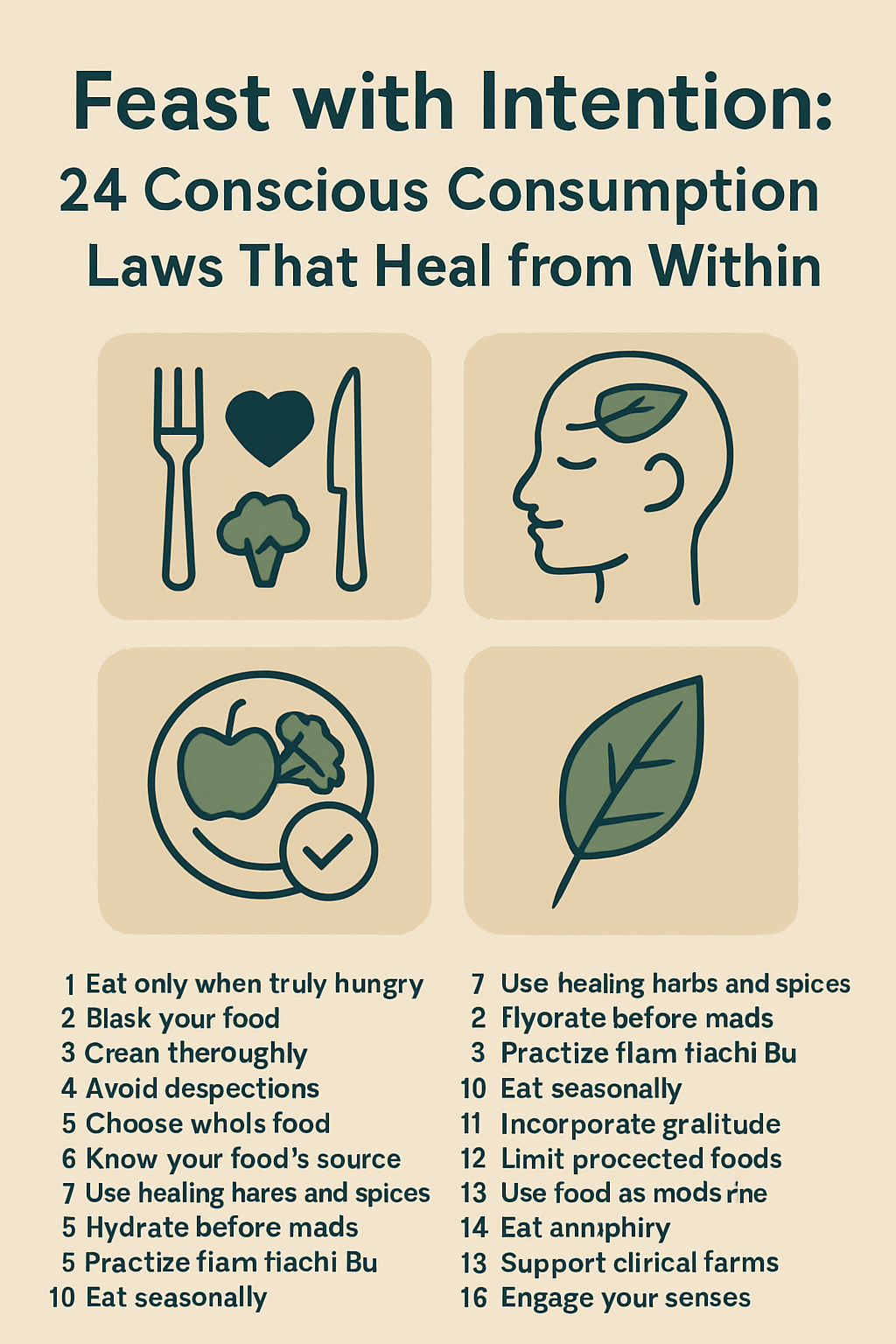focus keyword:Conscious Consumption
Published by ihoxi.xyz
In a world saturated with fast food, mindless snacking, and emotional eating, Feast with Intention: 24 Conscious Consumption Laws That Heal from Within is more than a slogan — it’s a call to awakening. The way we eat reflects how we live. And how we live directly affects how we heal — physically, emotionally, and spiritually.
What is Conscious Consumption?
Conscious consumption means being fully present during meals, understanding where your food comes from, and aligning your choices with your values and health goals. It goes beyond “eating healthy” — it’s about nourishing your entire being.
Explore the foundational concept on our Complete Guide to Conscious Eating.
24 Conscious Consumption Laws That Heal from Within
- Eat only when truly hungry, not emotionally triggered.
- Bless your food before eating — spiritually or silently.
- Chew each bite at least 20 times to activate digestion.
- Eat seated, away from screens and distractions.
- Consume whole, unprocessed foods 80% of the time.
- Know the origin of your ingredients.
- Use herbs and spices for healing, not just flavor.
- Hydrate with clean water — 30 mins before meals, not during.
- Stop eating when 80% full (the Japanese “Hara Hachi Bu”).
- Honor seasonal eating — nature knows what you need.
- Incorporate gratitude practices at the table.
- Limit sugar, seed oils, and ultra-processed foods.
- Use food as medicine — not escape.
- Eat slowly, mindfully — no rushing.
- Support local, ethical, and regenerative farms.
- Involve your senses — sight, smell, texture.
- Don’t demonize food — cultivate neutrality.
- Eat in silence at least once a week for reset.
- Share meals with people who uplift your energy.
- Fasting occasionally can renew body and mind.
- Cook with intention — it becomes part of the meal.
- Use natural, non-toxic cookware.
- Say no to artificial flavors and preservatives.
- Trust your gut — literally and intuitively.
Healing Begins at the Table
Every meal is a chance to restore your vitality and deepen your connection with yourself. Feast with Intention: 24 Conscious Consumption Laws That Heal from Within reminds us that nourishment is sacred. It’s time to replace autopilot eating with conscious rituals that honor body and soul.
Learn how this philosophy ties into Blue Zones longevity principles.
Visit a Conscious Retreat Near You
Want to dive deeper into intentional living and mindful nourishment? Consider visiting a conscious healing retreat: https://www.google.com/maps/embed?pb=!1m18!1m12!1m3!1d3151.8354345091287!2d144.9630579159041!3d-37.81362784201102!2m3!1f0!2f0!3f0!3m2!1i1024!2i768!4f13.1!3m3!1m2!1s0x6ad65d43f0edc68b%3A0x3edb1a7782ad4e9b!2sMelbourne%20Mindfulness%20Foundation!5e0!3m2!1sen!2sau!4v1624973734204!5m2!1sen!2sau
Start Your Journey Today
You don’t need to change your entire diet overnight. Start with one of the laws above. Apply it for a week. Then build from there. As you begin to feast with intention, you’ll notice shifts in your digestion, mood, energy, and clarity.
For more lifestyle guidance, visit our Wellness Blog or read our Free Mindful Eating eBook.
© 2025 ihoxi.xyz | Privacy Policy | Contact Us
Why We Must Feast with Intention
In a fast-paced world where meals are often consumed in front of screens or on the go, the concept of intentional eating is revolutionary. Feast with Intention: 24 Conscious Consumption Laws That Heal from Within invites us to slow down and reconnect with food as a sacred, healing force. Every meal can either harm or heal — the choice begins with awareness.
What is Conscious Consumption Really About?
Conscious consumption means more than just selecting organic products. It’s about understanding the journey of food — from seed to plate — and choosing with both your body and the planet in mind. It’s a lifestyle shift that prioritizes quality over quantity, presence over convenience, and healing over habit. Learn more about how to start conscious eating on ihoxi.xyz.
The Power of the 24 Laws
Each of the 24 laws in Feast with Intention: 24 Conscious Consumption Laws That Heal from Within is a gateway to deeper well-being. From chewing each bite mindfully to sourcing ethical ingredients, these laws help reprogram our relationship with food. They’re not about restriction — they’re about freedom, empowerment, and trust in our body’s innate wisdom.
Healing the Body, Honoring the Planet
When we choose to eat consciously, we’re not just nurturing our bodies — we’re also healing the Earth. Conscious consumption encourages plant-forward eating, low-waste lifestyles, and ethical sourcing. Supporting local farmers and seasonal produce reduces your carbon footprint and helps create a food system that’s regenerative rather than destructive.
Start with One Simple Shift
You don’t need to adopt all 24 laws overnight. Begin with one. Try drinking a glass of water 30 minutes before your meal instead of during. Or take a deep breath before your first bite. These small shifts add up to big changes in how your body digests, absorbs, and utilizes nutrients — both physically and energetically.
Transform Meals into Mindful Rituals
Mealtime can become a daily act of devotion. Light a candle. Play soft music. Eat in silence. Thank the farmers, the earth, and even your body for the ability to digest. These mindful rituals bring reverence back into the most common act of our day — eating. When intention enters the kitchen, healing begins long before the first bite.
Build Community Around Conscious Eating
Healing isn’t meant to be done alone. Invite friends to a mindful meal. Host a potluck where each dish has a story or cultural root. Visit a farmers’ market together. Community adds accountability and joy to the practice of feasting with intention. Share your journey using #FeastWithIntention.

Explore Healing Locations Near You
Want to take your practice to the next level? Visit a mindful wellness center or conscious retreat. These spaces offer immersive environments where food is prepared with intention, meditation is part of the meal, and every bite is a ceremony. https://www.google.com/maps/embed?pb=!1m18!1m12!1m3!1d3151.8354345091287!2d144.9630579159041!3d-37.81362784201102!2m3!1f0!2f0!3f0!3m2!1i1024!2i768!4f13.1!3m3!1m2!1s0x6ad65d43f0edc68b%3A0x3edb1a7782ad4e9b!2sMelbourne%20Mindfulness%20Foundation!5e0!3m2!1sen!2sau!4v1624973734204!5m2!1sen!2sau
Take Action: Begin Your Conscious Eating Journey Today
The journey to health starts not with a diet, but with a decision. A decision to slow down, show up, and eat with reverence. Whether it’s saying a short prayer, sourcing organic ingredients, or turning off distractions — every small action creates a ripple of change. Feast with Intention: 24 Conscious Consumption Laws That Heal from Within is not a rulebook — it’s an invitation. Are you ready?
Explore our full list of 24 Conscious Consumption Laws and start applying them one by one.
FAQ 1: What does it mean to “Feast with Intention”?
To “Feast with Intention” means eating with mindfulness, presence, and purpose. Instead of eating on autopilot, you become aware of what you’re eating, why you’re eating it, and how it affects your body, mind, and energy.
FAQ 2: How do the 24 Conscious Consumption Laws help healing?
The 24 laws are designed to reset your relationship with food. They encourage natural digestion, balanced energy, emotional stability, and alignment between your eating habits and your deeper wellness goals.
FAQ 3: Can I practice conscious eating if I have a busy schedule?
Absolutely. Even small shifts like chewing slower, eating without your phone, or blessing your food take little time but offer big benefits. The goal is progress, not perfection.
FAQ 4: Is this approach based on a specific diet?
No. The philosophy of “Feast with Intention” works with any dietary path — plant-based, omnivore, paleo, keto, etc. The focus is on awareness, not strict food rules.
FAQ 5: How does intention affect digestion?
When you eat with intention, you activate the parasympathetic nervous system — also known as “rest and digest.” This helps your body release enzymes and absorb nutrients more efficiently, so intention affect digrstion.
FAQ 6: What’s an example of a mindful eating ritual?
A simple example is sitting down for your meal, taking three deep breaths, expressing gratitude, and eating slowly without distractions. This creates a sacred space around your food it is mindful eating ritual example.
FAQ 7: Are these laws backed by science?
Yes. Many of the laws — such as chewing thoroughly, fasting occasionally, and avoiding processed food — are supported by both modern nutritional science and ancient wellness systems like Ayurveda are baked by science.
FAQ 8: How can I start applying the 24 laws?
Start with just one law — for example, avoid eating while distracted. After a few days, layer in another. Over time, these habits become second nature and lead to long-term wellness.
FAQ 9: Do I need to be spiritual to practice this?
Not at all need to be spiritual to practice this but some people really need. While some people incorporate gratitude or prayer, the core of “Feast with Intention” is simply awareness. It’s equally accessible for secular, spiritual, or religious individuals.
FAQ 10: Is this the same as intuitive eating?
They’re similar, but not identical. Intuitive eating focuses on listening to body cues. Conscious consumption adds layers of intention, ethics, and healing to the process of choosing and eating food.
FAQ 11: How can I involve my family in this practice?
Start by modeling the behavior yourself. Invite your family to share one tech-free meal a week or cook together. Turn meals into moments of connection, not conflict or control. Then you start involve your family in this practice.
FAQ 12: What’s the difference between eating healthy and eating consciously?
Eating healthy focuses on food quality. Eating consciously goes deeper — it includes how, when, and why you eat. Conscious eating blends physical nourishment with emotional and energetic alignment.Eating healthy is good for your health and diet.it is very important for your body health.
FAQ 13: Does conscious consumption help with emotional eating?
Yes. By pausing and becoming present, you create space between emotion and action. This helps reduce impulsive eating and strengthens self-awareness around food triggers. Thus conscious consumption help with emotional eating.
FAQ 14: Can I still eat my favorite comfort foods?
Yes — in moderation and with intention you still eat your favorite foods. Conscious consumption is not about restriction but about choice. If you truly want a treat, enjoy it slowly and savor it fully, without guilt.
FAQ 15: What role does gratitude play in healing through food?
Gratitude shifts your nervous system from stress to calm. When you eat with appreciation — for the farmers, the earth, the meal — your digestion and emotional state improve naturally.
FAQ 16: How do I deal with cravings while practicing these laws?
Cravings are natural, but when you eat consciously, you begin to notice what’s behind them. Often it’s not hunger but emotion, habit, or imbalance. Respond with compassion and awareness, not judgment.
FAQ 17: Where can I learn more about the 24 conscious consumption laws?
You can visit our full guide at ihoxi.xyz/conscious-consumption-laws to explore each law in depth and learn how to apply them in daily life.
FAQ 18: How can I maintain conscious eating in social settings or at restaurants?
Maintaining conscious consumption in social settings starts with preparation and intention. Before attending an event, remind yourself of the principles that matter most to you — such as eating slowly, making conscious choices, or stopping when you’re full. At restaurants, scan the menu for whole, minimally processed options. You don’t have to be perfect — it’s about making the best choices available without stress or guilt. If the meal is out of your control, focus on being present, chewing slowly, and practicing gratitude. Eating consciously is less about the food itself and more about the energy and awareness you bring to the moment, regardless of the setting.
FAQ 19: Can conscious consumption help with digestive issues like bloating or acid reflux?
Yes, conscious eating habits are often incredibly helpful for reducing digestive discomfort such as bloating, indigestion, and acid reflux. By slowing down your meals, chewing thoroughly, and avoiding distractions like screens, you support your digestive system in breaking down food efficiently. Eating smaller portions and stopping before you’re completely full can reduce pressure on the stomach, a common cause of reflux. Additionally, many of the 24 laws — like hydrating before meals instead of during and choosing whole foods over processed ones — ease the burden on the gut. Over time, these mindful practices can help retrain the digestive system and significantly reduce symptoms.
FAQ 20: How do I stay consistent with these 24 laws during travel or busy seasons?
Traveling or navigating a busy schedule can disrupt your routine, but it doesn’t have to derail your commitment to conscious consumption. Instead of trying to follow all 24 laws, choose a few that are most portable and flexible — like eating without distractions, chewing thoroughly, or expressing gratitude before meals. You can also carry healthy snacks, stay hydrated, and research food options in advance. Remember that intention is more important than perfection. The goal is not rigid compliance, but carrying the spirit of conscious eating with you wherever you go. Even if your food options are limited, you can still practice presence, choice, and mindfulness.

FAQ 21: How long does it take to notice results from eating with intention?
Results vary based on the person and the depth of their habits, but many people begin noticing positive changes within 1 to 2 weeks. These may include improved digestion, more energy, better sleep, reduced cravings, and emotional clarity. Over a few months, the results often deepen — people report stronger immunity, weight balance, mental focus, and even shifts in their emotional relationships with food. Healing through conscious consumption is a gradual process, not an overnight fix. Think of it as a long-term lifestyle, not a quick strategy. The more consistent and honest your practice is, the more profound and lasting the benefits will be.
FAQ 22: What if I live in a food desert or have limited access to organic options?
Living in a food desert or facing economic limitations doesn’t disqualify you from practicing the core values of conscious eating. While organic or locally sourced foods are ideal, they are not the only way to eat intentionally. You can still choose whole over processed, cook meals at home, eat slowly, and be present during meals. Canned beans, frozen vegetables, and bulk grains are affordable and nutritious options. Community gardens, food co-ops, or local programs may also help bridge the gap. Remember, the heart of conscious consumption is mindfulness, gratitude, and intention — these qualities are available no matter your budget or location.
Final Thoughts
In a world that often encourages speed, distraction, and disconnection, choosing to feast with intention is a quiet act of rebellion — and a powerful one. The 24 Conscious Consumption Laws are not rigid rules, but gentle invitations to return to the wisdom of your body, the rhythm of the Earth, and the sacredness of each bite.
Healing doesn’t begin with a supplement or a new diet — it begins with awareness. When you slow down, chew consciously, listen to your body, and express gratitude for your meals, you’re not just nourishing yourself — you’re honoring the invisible threads that connect you to the soil, to farmers, to tradition, and to your future self.
Start small. Be patient. Let intention guide your eating journey. As you practice these laws day by day, you’ll begin to notice profound shifts — not only in your health, but in your mindset, your energy, and your connection to life itself. That’s the real healing: from within.
Want support on your conscious consumption journey? Explore our wellness blog, download our free Mindful Eating eBook, or connect with our community on Instagram. Let’s grow together — one mindful meal at a time.






